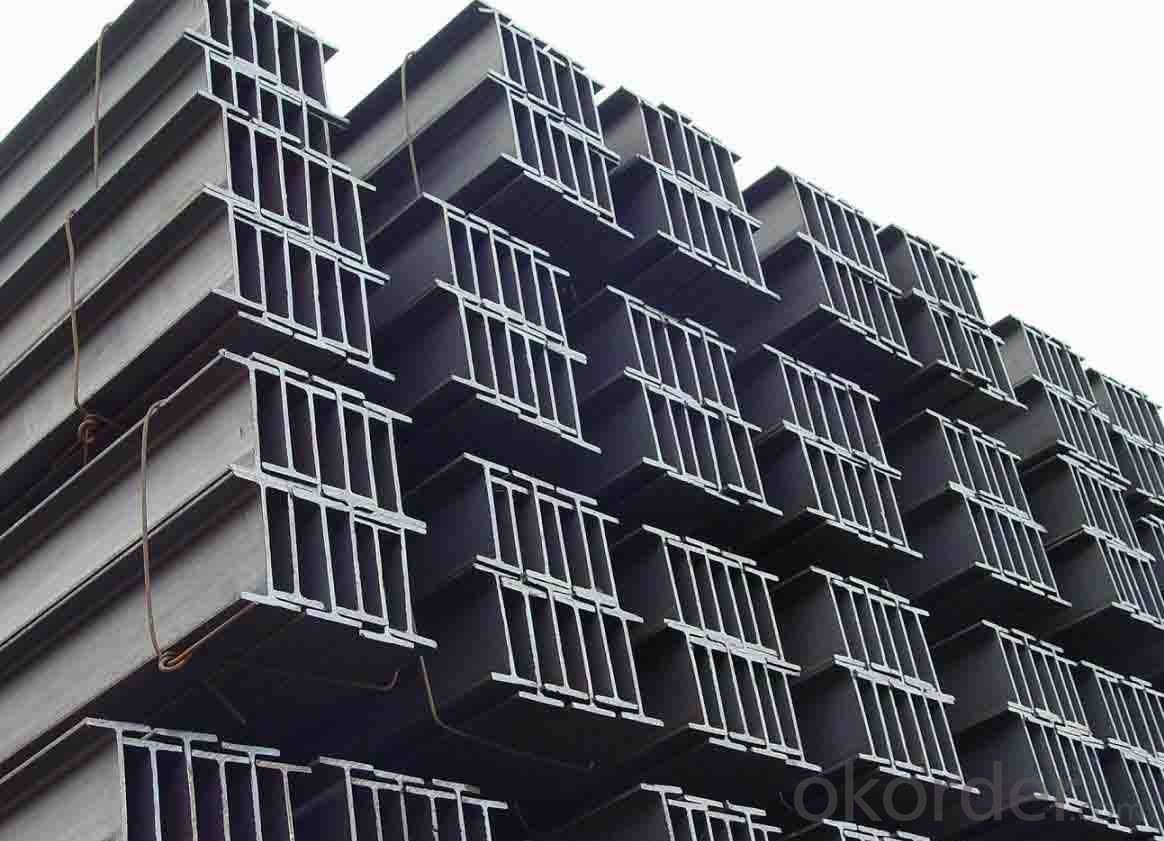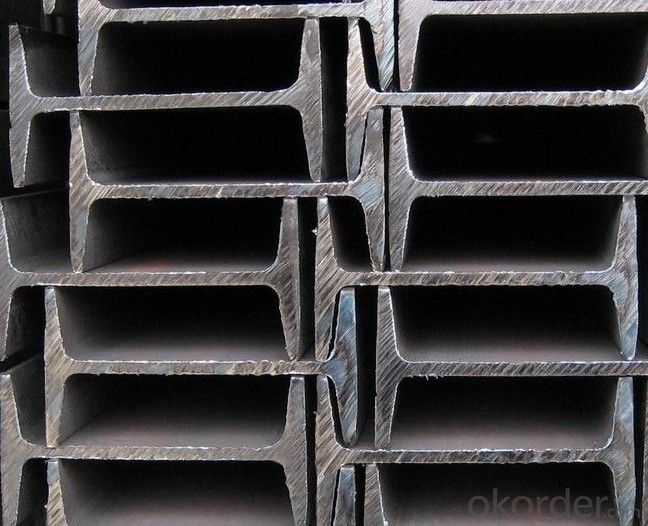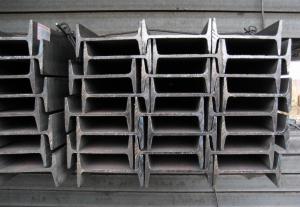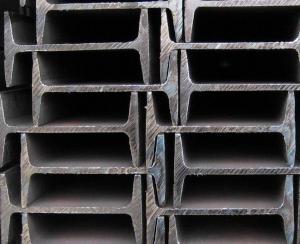IPE/IPEAA Beam in Material Grade GB-Q235
- Loading Port:
- Tianjin
- Payment Terms:
- TT OR LC
- Min Order Qty:
- 25 m.t.
- Supply Capability:
- 10000 m.t./month
OKorder Service Pledge
OKorder Financial Service
You Might Also Like
Product Description:
OKorder is offering high quality Hot Rolled Steel I-Beams at great prices with worldwide shipping. Our supplier is a world-class manufacturer of steel, with our products utilized the world over. OKorder annually supplies products to European, North American and Asian markets. We provide quotations within 24 hours of receiving an inquiry and guarantee competitive prices.
Product Applications:
1. Supporting members, most commonly in the house raising industry to strengthen timber bears under houses. Transmission line towers, etc
2. Prefabricated structure
3. Medium scale bridges
4. It is widely used in various building structures and engineering structures such as roof beams, bridges, transmission towers, hoisting machinery and transport machinery, ships, industrial furnaces, reaction tower, container frame and warehouse etc.
Product Advantages:
OKorder's Steel I-Beams are durable, strong, and resist corrosion.
Main Product Features:
· Premium quality
· Prompt delivery & seaworthy packing (30 days after receiving deposit)
· Corrosion resistance
· Can be recycled and reused
· Mill test certification
· Professional Service
· Competitive pricing
Product Specifications:
1. Invoicing on theoretical weight or actual weight as customer request
2. Standard: EN10025, GB Standard, ASTM
3. Grade: Q235B, Q345B, SS400, ASTM A36, S235JR, S275JR
4. Length: 5.8M, 6M, 9M, 12M as following table
5. Sizes: 80mm-270mm
Dimensions(mm) | |||||
h | b | s | t | Mass Kg/m | |
IPE80 | 80 | 46 | 3.80 | 5.20 | 6.00 |
IPE100 | 100 | 55 | 4.10 | 5.70 | 8.10 |
IPE120 | 120 | 64 | 4.80 | 6.30 | 10.40 |
IPE140 | 140 | 73 | 4.70 | 6.90 | 12.90 |
IPE160 | 160 | 82 | 5.00 | 7.40 | 15.80 |
IPE180 | 180 | 91 | 5.30 | 8.00 | 18.80 |
IPE200 | 200 | 100 | 5.60 | 8.50 | 22.40 |
IPE220 | 220 | 110 | 5.90 | 9.20 | 26.20 |
IPE240 | 240 | 120 | 6.20 | 9.80 | 30.70 |
IPE270 | 270 | 135 | 6.60 | 10.20 | 36.10 |
FAQ:
Q1: Why buy Materials & Equipment from OKorder.com?
A1: All products offered byOKorder.com are carefully selected from China's most reliable manufacturing enterprises. Through its ISO certifications, OKorder.com adheres to the highest standards and a commitment to supply chain safety and customer satisfaction.
Q2: How do we guarantee the quality of our products?
A2: We have established an advanced quality management system which conducts strict quality tests at every step, from raw materials to the final product. At the same time, we provide extensive follow-up service assurances as required.
Q3: How soon can we receive the product after purchase?
A3: Within three days of placing an order, we will begin production. The specific shipping date is dependent upon international and government factors, but is typically 7 to 10 workdays.
Images:


- Q:How do you calculate the moment capacity of a steel I-beam?
- In order to determine the moment capacity of a steel I-beam, various factors need to be taken into consideration. These factors include the dimensions of the beam, the properties of the material used, and the conditions under which it will be loaded. The moment capacity refers to the beam's ability to withstand bending forces. To begin with, one must ascertain the dimensions of the I-beam, including its height (h), the width of the flanges (b), the thickness of the flanges (tf), the thickness of the web (tw), and its length (L). These dimensions can either be obtained from the manufacturer's specifications or by directly measuring the beam. Next, one must determine the material properties of the steel, such as its yield strength (Fy) and elastic modulus (E). These values can also be obtained from the manufacturer's specifications or reference materials. Once the dimensions and material properties are known, the moment of inertia (I) of the beam can be calculated. The moment of inertia measures how the beam's mass is distributed around its axis and determines its resistance to bending. The following formula can be used to calculate the moment of inertia: I = (1/12) * (b * h^3 - (b - 2 * tf) * (h - 2 * tf)^3) + (Aweb * tw^2 * (h/2 - tw/2)^2) Here, Aweb represents the area of the web. After obtaining the moment of inertia, the section modulus (S) of the beam can be determined. The section modulus is a measure of the beam's resistance to bending and is calculated as: S = I / (h/2) Finally, the moment capacity (Mc) of the beam can be calculated using the following formula: Mc = Fy * S In conclusion, it should be noted that these calculations provide an estimate of the moment capacity. Actual results may vary due to factors such as material imperfections, manufacturing processes, and load distribution. Therefore, it is advisable to consult structural engineering codes and standards, as well as seek the guidance of professional engineers, to ensure accurate and safe calculations for specific applications.
- Q:Can steel I-beams be used for modular bridges or flyovers?
- Yes, steel I-beams can be used for modular bridges or flyovers. Steel I-beams are commonly used in the construction industry due to their strength, durability, and versatility. They are capable of bearing heavy loads and providing stability, which makes them suitable for various applications, including bridge construction. Modular bridges or flyovers are often designed to be prefabricated in sections and then assembled on-site, allowing for a faster and more efficient construction process. Steel I-beams are well-suited for modular construction as they can be easily fabricated to the required specifications and transported to the site for assembly. The use of steel I-beams in modular bridge or flyover construction offers several advantages. Firstly, steel is a lightweight material compared to alternatives like concrete, making it easier and more cost-effective to transport and assemble. Additionally, steel I-beams can be designed to withstand different types of loads, such as the weight of vehicles or large crowds, ensuring the structural integrity and safety of the bridge or flyover. Furthermore, steel I-beams provide flexibility in terms of design and adaptability to different site conditions. They can be easily modified or extended if necessary, allowing for future expansion or modifications. Steel also possesses excellent resistance to corrosion, which is crucial for structures exposed to outdoor elements and harsh environmental conditions. In conclusion, steel I-beams are a suitable choice for modular bridges or flyovers due to their strength, durability, versatility, and ease of assembly. Their use ensures the construction of safe and reliable structures that can withstand heavy loads and adapt to changing requirements.
- Q:Can steel I-beams be used for distribution centers?
- Yes, steel I-beams can be used for distribution centers. Steel I-beams are commonly used in the construction of large industrial buildings, including distribution centers, due to their strength, durability, and ability to support heavy loads.
- Q:How do you protect steel I-beams from corrosion?
- Applying a protective coating is highly effective in safeguarding steel I-beams against corrosion. Various coating options, such as paint, epoxy, or galvanization, are available, each with its own advantages and suitability for different environments. Paint coatings act as a barrier, preventing moisture and oxygen from reaching the steel surface and causing corrosion. To ensure proper corrosion protection, it is crucial to use high-quality paint specifically designed for this purpose. Adequate surface preparation and application techniques are necessary, and regular maintenance and touch-ups may be needed as paint coatings can deteriorate over time. Epoxy coatings provide superior corrosion resistance and durability compared to paint. These coatings are typically applied in multiple layers, creating a thicker and more robust protective barrier. They are commonly used in highly corrosive environments, such as offshore structures or chemical plants. Galvanization is another effective method for protecting steel I-beams from corrosion. It involves coating the steel with a layer of zinc, which acts as a sacrificial anode. The zinc corrodes preferentially, sacrificing itself to protect the steel. The most common galvanization method is hot-dip, where the steel is immersed in molten zinc. This process results in a thick, durable, and long-lasting protective coating. In addition to using protective coatings, regular maintenance and inspections are crucial. Prompt addressing of any signs of damage or corrosion is essential to prevent further deterioration. Routine cleaning, debris removal, and ensuring proper drainage around the I-beams can also help prevent corrosion. Considering the specific environment and conditions in which the steel I-beams will be exposed is important. Seeking advice from corrosion specialists or engineers can provide valuable recommendations on the most suitable corrosion protection methods for the given application.
- Q:How do steel I-beams perform in high-humidity environments?
- Due to their inherent resistance to moisture, steel I-beams perform well in high-humidity environments. Typically, the steel used in I-beams is coated with protective finishes like galvanization or paint. These finishes act as barriers to prevent moisture penetration and direct contact with water or humidity, thus preventing corrosion. Moreover, steel is a non-porous material, unlike wood or other organic materials. This non-porous characteristic makes steel I-beams less prone to swelling, warping, or rotting that can occur in high-humidity conditions. However, in extremely corrosive environments such as coastal areas with high salt content in the air, additional precautions may be necessary. In such cases, stainless steel or other corrosion-resistant alloys are commonly utilized to ensure the durability and performance of the I-beams. All in all, steel I-beams are a reliable choice for high-humidity environments. They offer strength, durability, and resistance to moisture-related issues.
- Q:How do you calculate the moment due to axial load in a steel I-beam?
- To calculate the moment due to axial load in a steel I-beam, you need to multiply the axial load by the distance from the centroid of the section to the point where the moment is being measured. This product gives you the moment caused by the axial load.
- Q:How do steel I-beams contribute to the overall sustainability of a construction project?
- Steel I-beams contribute to the overall sustainability of a construction project in several ways. Firstly, steel is a highly durable and long-lasting material. Steel I-beams have a lifespan of several decades and can withstand extreme weather conditions and heavy loads without deteriorating. This longevity reduces the need for frequent replacement and repairs, reducing waste and conserving resources in the long run. Secondly, steel is a highly recyclable material. Steel I-beams can be easily recycled at the end of their lifespan, with the recycled steel being used to create new products. This recycling process significantly reduces the demand for raw materials and energy required for steel production, leading to a lower carbon footprint. Moreover, steel I-beams are lightweight compared to other construction materials such as concrete. This reduces the weight load on the foundation and overall structure, resulting in reduced materials and less energy consumption during construction. Additionally, the lightweight nature of steel I-beams allows for more efficient transportation, reducing fuel consumption and greenhouse gas emissions during transportation. Furthermore, steel I-beams are versatile and can be prefabricated off-site. This reduces construction waste and minimizes the impact on the surrounding environment during the construction process. Prefabrication also allows for faster construction, reducing the overall project timeline and minimizing disruption to the surrounding community. Lastly, steel I-beams can be designed and engineered to optimize energy efficiency. They can be integrated with insulation materials, thermal breaks, and other energy-saving features to enhance the overall energy performance of a building. This leads to reduced energy consumption for heating and cooling, resulting in lower operational costs and a smaller environmental footprint. In conclusion, steel I-beams contribute to the overall sustainability of a construction project through their durability, recyclability, lightweight nature, versatility, and potential for energy efficiency. They promote responsible resource use, waste reduction, and energy conservation, making them an environmentally-friendly choice for construction.
- Q:What are the common design software used for steel I-beam analysis?
- Steel I-beam analysis can be carried out using various design software programs that are widely used in the industry. Some of the most well-known options are: 1. STAAD.Pro: This software is extensively utilized in structural analysis and design, including the analysis of steel I-beams. Its features encompass advanced modeling capabilities, finite element analysis, and comprehensive design functions. 2. ETABS: Primarily employed for building analysis and design, ETABS can also be utilized for steel I-beam analysis. It offers robust tools for analyzing and designing steel structures, including I-beams. 3. SAP2000: Another popular software for structural analysis and design, SAP2000 also incorporates features specifically designed for steel I-beam analysis. It boasts a user-friendly interface and advanced analysis capabilities. 4. Tekla Structures: This software is predominantly employed for building information modeling (BIM) and is extensively used in the construction industry. It provides tools for detailed modeling, analysis, and design of steel structures, including I-beams. 5. RISA-3D: RISA-3D is a versatile software program that finds application in structural analysis and design. It offers comprehensive analysis and design capabilities for steel structures, encompassing I-beams. These examples demonstrate the commonly used design software programs for steel I-beam analysis. The selection of software depends on factors such as project requirements, user preference, and the specific design needs of the steel I-beam structure.
- Q:How do steel I-beams compare to reinforced concrete beams in terms of cost and performance?
- Steel I-beams typically have a lower initial cost compared to reinforced concrete beams due to the more efficient manufacturing process. However, reinforced concrete beams offer longer-term cost savings as they require less maintenance and have a longer lifespan. In terms of performance, steel I-beams provide superior strength-to-weight ratio, allowing for longer spans and more flexibility in design. On the other hand, reinforced concrete beams offer better fire resistance and soundproofing properties. Ultimately, the choice between steel I-beams and reinforced concrete beams depends on the specific project requirements, budget, and desired performance characteristics.
- Q:How do you reinforce a steel I-beam?
- Different methods can be utilized to reinforce a steel I-beam, depending on the specific circumstances and requirements. Here are a few commonly employed approaches: 1. Welding extra steel plates: One way to reinforce the I-beam is by welding additional steel plates onto its flanges or web. These plates can be strategically placed to enhance the beam's load-carrying capacity and strength. The size and thickness of the plates will depend on the necessary reinforcement. 2. Incorporating steel sections: Another option involves adding supplementary steel sections to the existing I-beam. This can be achieved by welding or bolting them together to form a composite beam. By combining multiple beams, the overall stiffness and strength of the structure can be improved. 3. Implementing external bracing: External bracing can be employed to reinforce the I-beam. This entails attaching braces or cross-members to the beam to provide additional support and prevent buckling or twisting. Bracing can be made from various materials such as steel or concrete, and its design will be tailored to the specific load and structural requirements. 4. Using carbon fiber reinforcement: Carbon fiber materials can be utilized to strengthen steel I-beams. Carbon fiber sheets or strips can be bonded to the beam's surface using epoxy resin. This technique adds strength and stiffness to the beam while also offering corrosion resistance and maintaining a lightweight structure. 5. Employing post-tensioning: Post-tensioning is a technique where high-strength steel tendons or cables are installed within the beam and then tensioned. This process applies compressive forces to the beam, increasing its load-carrying capacity and reducing deflection. Post-tensioning is commonly employed in larger structures and requires specialized expertise. It is important to emphasize that the reinforcement of a steel I-beam should only be carried out by a qualified structural engineer or professional who possesses knowledge of the specific requirements and load conditions. They can evaluate the structural needs, determine the necessary reinforcement, and ensure that the modifications comply with relevant building codes and standards.
1. Manufacturer Overview |
|
|---|---|
| Location | |
| Year Established | |
| Annual Output Value | |
| Main Markets | |
| Company Certifications | |
2. Manufacturer Certificates |
|
|---|---|
| a) Certification Name | |
| Range | |
| Reference | |
| Validity Period | |
3. Manufacturer Capability |
|
|---|---|
| a)Trade Capacity | |
| Nearest Port | |
| Export Percentage | |
| No.of Employees in Trade Department | |
| Language Spoken: | |
| b)Factory Information | |
| Factory Size: | |
| No. of Production Lines | |
| Contract Manufacturing | |
| Product Price Range | |
Send your message to us
IPE/IPEAA Beam in Material Grade GB-Q235
- Loading Port:
- Tianjin
- Payment Terms:
- TT OR LC
- Min Order Qty:
- 25 m.t.
- Supply Capability:
- 10000 m.t./month
OKorder Service Pledge
OKorder Financial Service
Similar products
New products
Hot products
Related keywords



























